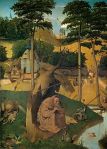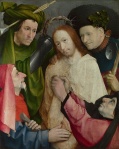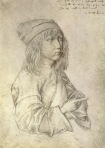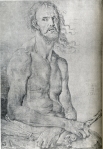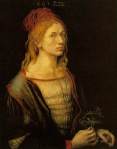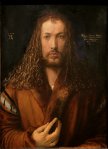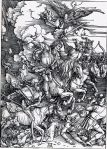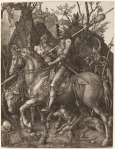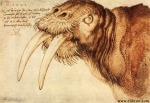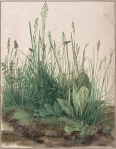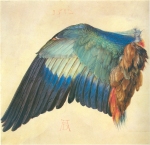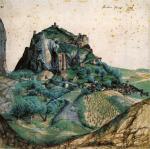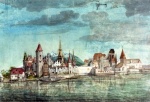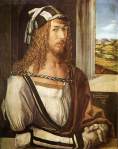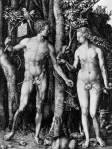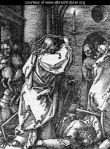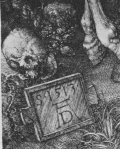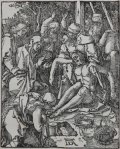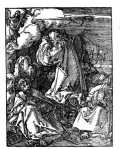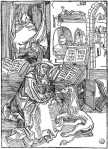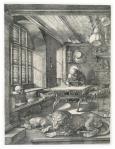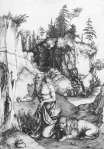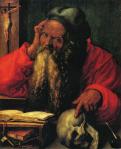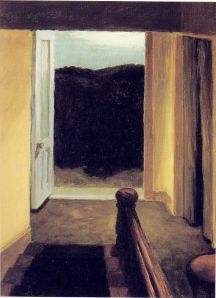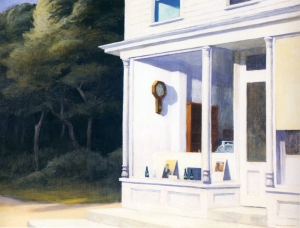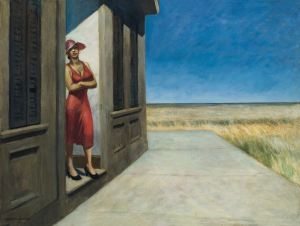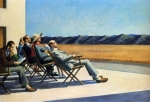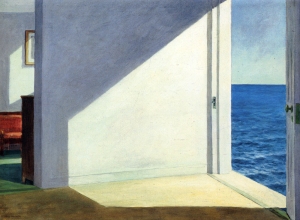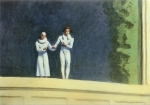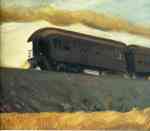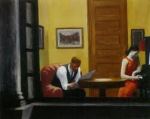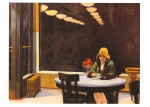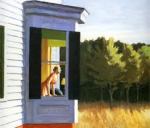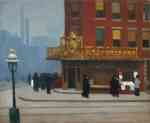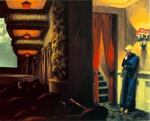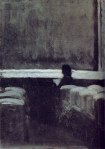
Ted Hughes: 14 Poems from "Crow" (new episode) – Human Voices Wake Us
Entries in the Anthology series organize my favorite anecdotes about artists, writers, and historical events, and are always being updated. While I love and depend on the exhaustive biography or study, in many ways the disconnected stories and fragments have been more important in my day-to-day living with art, literature and history. As such, nothing original is assumed here, and nearly everything in these pieces is built either on quotations from the historical personages themselves, or from the scholars who have written about them.
[1] Laurinda Dixon begins her book on the Netherlandish painter Hieronymus Bosch (c. 1450-1516) by discussing the difficulty of dating his work, or even of pinning down which works are actually his. She notes the varied styles that are evident even in the same painting, especially in something like The Garden of Earthly Delights, and suggests that, like many painters, Bosch may have merely been the head of a workshop which carried his name. And as Bosch came from an artistic family, his workshop would have consisted of a “family dynasty of painters.”
[2] This idea of a workshop goes against our modern notion of an artist, which usually involves a lonely (and probably disagreeable) fellow who also happens to be a genius, and no doubt the strange creatures that populate Bosch’s work helps this notion along. But Dixon’s book is valuable in part for illuminating that transition in history from when the artist was assigned “a relatively low status … so much so that most fifteenth-century painters did not even sign their works,” into the modern notion of the artist as an “original creator.” While Italian artists of the period “were enjoying an elevated status as intellectuals and geniuses,” and while his contemporary to the south, Albrecht Dürer (who had traveled to Italy) “documented his views and his extraordinary accomplishments in numerous personal diaries and letters, there is no reason to believe that Bosch would have done so.”
Yet this somehow seems appropriate, since just as there is very little biographical information on Bosch, there also seem to be very little of the individual personality (which we’ve also come to expect) in the people he depicts. Perhaps there are exceptions—such as his crouching Saint Anthony; or closed-eyed Christ swarmed by a terrifying crowd; or background characters like the men in his Adoration of the Magi, leaning through a window to warm their hands over a fire—but in general Bosch’s people are more symbolic than personable.
For all that, though, his people, his composite creatures, and his strange landscapes do contain a strange attraction, a strange familiarity.
[3] Bosch’s religious devotion goes without saying. He and his brother were both members of the confraternity of the Brotherhood of Our Lady. Members attended to a miracle-working shrine of the Virgin, the Zoete Lieve Vrouw, and also provided “music and performers for the daily liturgy and special feast days.” As a more elevated, “sworn” member of the confraternity, Bosch “would have worn his hair tonsured and was privileged to don a colourful cowl, embellished with the organization’s emblem, the lily among thorns.”
[4] Bosch was among those painters of the Northern Renaissance (as distinct from the Italian Renaissance) “credited with introducing worldly realism and human emotion into the predominantly religious subjects inherited from the Gothic tradition.” In a world dominated both by religion and illiteracy, religious art rather than literature was the main vehicle of faith. As such, “Paintings were intended to be read like texts, and artists often collaborated with scholars and liturgical advisers when planning their compositions.”
This produced both layers of symbolism and hidden meanings within paintings, but also the simple interpretation of “sacred themes in everyday terms,” seen in a work from a century earlier, Holy Family at Work, where Mary is at her loom, Joseph is in his workshop, and a small Christ child is at a walker and who, “but for his small halo … could be any toddler.”
[5] In Bosch’s Crucifixion with Donor, the backdrop of Jesus’ death is not Jerusalem but “a simple Dutch town (complete with windmill),” and a similar contemporary setting is seen in Christ Carrying the Cross, Adoration of the Magi, and others.
Alongside contemporary setting is contemporary clothing, and indeed all of the tormentors in Bosch’s depictions of the passion and death of Christ (such as Christ Crowned with Thorns) are dressed in the clothing of his own day, some even with the crescent and star, denoting the Muslim Turks. This motif, which is common to all European artists once you begin looking for it, suggests to Dixon that they “represent the human race, past and present, which persists in tormenting Jesus.”
But if this is true, the opposite case is, as well. The setting for Holy Family at Work is “typical of a fifteenth century bourgeois abode,” while Bosch’s Christ Child with Whirligig and Walking Frame and Adoration of the Magi (complete with Dutch backdrop) suggest not just the humanity of Christ, but the holiness of the everyday, of all that is contemporary.
[6] One of my favorite works of Bosch is Death of a Miser, a tall, narrow scene of a hoarder, wasted away and near death, his cluttered room already invaded by demons and creatures who are waiting to make off with his things. Death, quite literally, is at his door; and despite the crucifix at his window and the imploring angel holding the dying man up, he seems by his gesture (towards death with one hand, to a bag of gold with the other) to have made another choice. It also removes the horror and gore and fear which scenes of death and demons usually inspire, and instead suggests a more disturbing option—sin and the devil are more subtle, insidious, and even playful, rummaging through a crowded room.
A literal companion to Death of a Miser (they were once part of a triptych) is Bosch’s The Wayfarer, which shows a man with a bandaged leg and walking stick leaving the indecorous scene of a brothel (note the groping couple in the doorway), a man urinating to the side of the building, and some well-placed pigs eating from a trough in the front yard. The Wayfarer itself shows great similarities to Bosch’s other Wayfarer, and Dixon notes with humor the variety of interpretations these scenes have engendered, given Bosch’s knowledge of religion, science, and the art of his own time: the two paintings apparently show “the Prodigal Son, the sin of sloth, a cheating peddler, the astrological image of Saturn, a Christian pilgrim, a repentant sinner and a pauper. Bosch’s sources have been seen as the treatises of the ancients, proverbs and moralizing axioms, medieval Middle Dutch plays, the Bible or the grim realities of life blighted by poverty…. Do the two pictures, in fact, represent different things, despite their similarities?”
[7] Dixon describes “Death of a Miser” as a scene of “willful folly,” willful because an entire selfish life has been lived, and filled with accumulating years of bad choices.
For some reason I’ve always connected the miser with the patient in Bosch’s Stone Operation. Apparently madness, or just “folly,” is being cured in this scene, although Dixon illustrates a wider meaning. Both a monk and a nun are watching this operation, and the nun has a book on her head to complement the surgeon’s funnel on his. Dixon, who writes so well of Bosch’s references and knowledge of alchemy, suggests Bosch is satirizing not alchemy, science, or religion, but only those who think such paths can be used as shortcuts, and the charlatans who abuse this gullibility.
She further notes that the apparent “stone” in the man’s head is not a stone at all, but a flower, identical to the one sitting on the table (an alchemical flower of wisdom), and that what the patient is actually requesting is that “the rigours of study and thought required in the pursuit of wisdom … be eliminated by a mere flick of the scalpel, or that the knowledge contained in a difficult book could pass into the brain by osmosis, simply by placing it on one’s head, as Bosch’s nun does.”
While this interpretation is impossible to prove, reading it I nevertheless equate this fellow, desperate for whatever easy answer he can get, with the various conspiracy theorists who crowd our world, or those who prefer their religion as easy and thoughtless as possible.
[8] In his Christ Carrying the Cross, Bosch crowds his Jesus around with a claustrophobic group of grotesque faces. Such depictions went along with the theories of the “physiognomic theorists” that associated “facial deformities … with specific character flaws.” So, just as contemporary thinkers and artists (such as Erasmus and Dürer) believed Christ to be “a man of medium height, with symmetrical, regular features, a fair complexion, thin beard and brownish-auburn hair,” his enemies were immediately recognizable by their ugliness. (This strategy continues to this day in Hollywood and popular fiction, where the good are beautiful and the evil are wormish and unpleasant-looking.) Unfortunately the appearance, specifically, of a large nose, many times shown in profile (such as Dürer’s Christ Among the Doctors) these “grotesques” were inevitably equated with Jews.
[9] Commenting on Bosch’s Crucified Martyr, a completely bloodless death of a fully-clothed and utterly unharmed-looking woman, Dixon writes that Bosch primarily “painted holy figures who lived in isolation and deprivation.” While Bosch could be morbid and brutal when he wanted, “morbid martyrdoms” didn’t interest him.
Indeed, his version of John the Baptist ignores his more dramatic execution and instead shows him serenely occupying a (Northern European) wilderness; his version of John of Patmos having the Book of Revelation dictated to him looks like a school lesson compared to Dürer’s version, where John is shown painfully swallowing scrolls; and his version of St. Anthony—also depicted in Northern Europe, rather than the deserts of Egypt—while indeed showing the demons with which that saint was tormented, nevertheless is also fairly serene, even sleepy.
[10] Dixon titles her chapter on Bosch’s Garden of Earthly Delights triptych “Science and Salvation,” and she does a magnificent job making Bosch’s settings and composite creatures less strange to the modern viewer, but no less wonderful to behold. In reference to contemporary illuminated manuscripts and ornamental architectural features, she assures us that Bosch’s “hybrid” creatures “would not have been new to his viewers.” And simply taking the bathing couple in his Garden, Dixon writes that they “all belong to the realm of Venus, familiar to viewers through astrological and humoral traditions…. It is clear that we in the twenty-first century lack the symbolic vocabulary that once supplied the key to Bosch’s patrons and public, whoever they were.”
And in reference to Bosch’s earlier Adoration of the Magi, in which surrounding buildings and structures resemble furnaces and laboratory equipment, she directly equates the goal of alchemy (the transmutation of base into noble metals) with the birth of Christ: “The Adoration, as a whole, reflects a common chemical analogy that compares the birth of Christ to the birth of the transmuting agent, the ‘philosopher’s stone’, ‘lapis’ or ‘elixir’,” going on to say that “the incarnation [is] the ultimate transmutation.”
It is hard for us today to imagine both science and religion acting this way, and doing so together. A long excerpt from Dixon is worth giving, describing the entire Garden: “In fact, the subject matter and organization of the Garden of Earthly Delights is identical to the oldest chemical allegory of all, which sees distillation as an imitation of creation, destruction and rebirth of the world and its inhabitants. In Christian thought, the ultimate example of the philosopher’s stone was the earth itself, God’s creation, which will achieve perfection after its final destruction as foretold in the Bible. The four separate scenes that comprise the Garden of Earthly Delights triptych delineate four basic steps in the alchemical work, which have both allegorical and practical significance: ‘conjunction’, in which ingredients are brought together for mixing, is represented by the left interior scene of the joining of Adam and Eve; the slow cooking and bringing together of the ingredients into an undifferentiated mulchy mass, the alchemical ‘child’s play’ step, appears in the riotous centre interior panel; next, the substances are burned and ‘killed’, in putrefaction, symbolized by Bosch’s diabolical hell scene; finally, the chemical ingredients are cleansed, resurrected and transmuted in their vessel, a stage that appears on the triptych’s exterior.”
[11] Finally, it should not surprise us that the “Garden” was acquired by the Spanish emperor Philip II, who had it placed in the Escorial monastery in San Lorenzo, and that this “devout Catholic … was neither shocked nor offended by the content of these paintings and, in fact, probably recognized and valued their deft synthesis of science and piety.”
Hapsburg rulers of later generations also acquired Bosch’s work, and it is recognized that under their patronage a “golden age of alchemy” came to be. Even Martin Luther had kind things to say about alchemy, “its virtue and manifold usefulness … [but also its] noble and beautiful likeness which it hath with the resurrection of the Dead on the Day of Judgment.”
Early chemists, Dixon writes, “defined their work as a means of bringing them nearer to God and viewed their research as a Christian duty,” words which science-fearing and literal-minded religious faithful of our own day should consider. While Bosch’s world contain elements no one nowadays would care to resurrect, the symbolic vocabulary his contemporaries could call on to deal with religion and science and the everyday are worth trying, however minimally, to recover.
Quotations from each of the sections came from the following:
[1] Laurinda Dixon, Bosch, 7.
[2] Ibid., 7, 15-16.
[3] Ibid., 27-8.
[4] Ibid., 27-8, 35-7.
[5] Ibid., 40, 141-2, 127-129.
[6] Ibid., 84-88, 89-90.
[7] Ibid., 55-62.
[8] Ibid., 132-7.
[9] Ibid., 149.
[10] Ibid., 39, 214, 233-4, 224-78.
[11] Ibid., 277-8.


